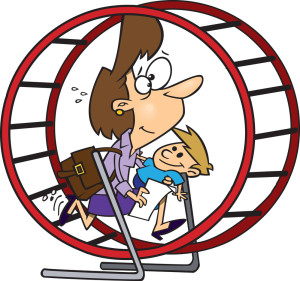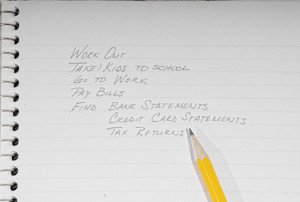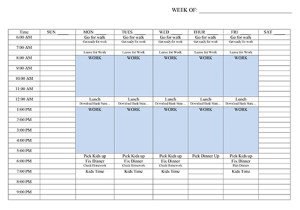Are you on the divorce hamster wheel and all you want to do is jump off???
Would you love to be able to take your time with the tasks at hand, spend a couple of hours relaxing and have the time to connect with those around you???
Being a family law paralegal and a CDFA I cannot tell you how many clients have looked at me like I was crazy when I went over the list of documents I would need them to produce or how many of them have ask me “and when do you expect me to get this done”. Besides stressing out about the whole divorce process my clients are trying to figure out their new life and schedules; while some are re-entering the work force others are having to learn how to schedule their children’s activities within their own schedule’s; while others are concerned with what their future holds for them.
While going through the divorce process the majority of people feel that they are always multitasking and have to cut things short to try and get everything done. They’re stressing about not being able to focus on their children’s needs or focus at work. They are wondering how they are going to get everything done and at times feeling like a failure because they are not able to respond to the requests made by their attorney in a timely manner.
Most people are not in a situation to hire an assistant to take over the divorce process for them. So if you are a normal person; what can you do to take on this challenge? Start by closing your eyes and taking a deep breath to begin clearing your mind so you can focus. How can you begin to clear your mind? Well the first step is to get a note pad and start  writing down what you need to get accomplished. Yes, I did say “WRITE” it down, don’t type your list on your computer, iPad, or cell phone; “WRITE” it down with a pen or pencil in a spiral notebook or a note pad.
writing down what you need to get accomplished. Yes, I did say “WRITE” it down, don’t type your list on your computer, iPad, or cell phone; “WRITE” it down with a pen or pencil in a spiral notebook or a note pad.
We are in the age of computers, iPads, and cell phones which all have “To Do List”; but there is nothing like actually writing down what you need to do. Your mind has what is called a “rehearsal loop”. The “rehearsal loop” passes or transfers information from short-term memory to long-term memory. The transfer will only take place if you have rehearsed the information several times in your head. As long as this loop is playing your mind will not begin to clear and you will remain on the hamsters wheel. There is some neuroscience behind physically writing your list deactivating the “rehearsal loop”.
Now get that pencil and notebook or note pad and start writing down your “TO DO LIST”.  Your “TO DO LIST” is a living list and will be added to periodically, maybe daily. Once you get your initial list complete, review each task and determine if the task is something that you must do, can delegate for someone else to do, can put the task off or decide you really don’t need to complete the task at all.
Your “TO DO LIST” is a living list and will be added to periodically, maybe daily. Once you get your initial list complete, review each task and determine if the task is something that you must do, can delegate for someone else to do, can put the task off or decide you really don’t need to complete the task at all.
Once you have your “TO DO LIST” and you have determined what you need to DO, what can be DELEGATED, what can be DEFERRED and what you can DROP you will set up your calendar and for this your cell phone will come in handy. Start out by scheduling when you are at work, make sure you schedule your lunch time. Now schedule what time you must leave the house by in order to get to work on time and also set up a reminder for let’s say 15 minutes before you need to walk out the door. Then put on your calendar your child(ren) activities that you need to take them to and again set a reminder. Now start scheduling the other items on your “TO  DO LIST”. If you know that it may take you a number of days to complete the task then make sure you have it listed a number of times on your calendar. If you enjoy working out then make sure you schedule time for your work outs. Make sure to set reminders for the time allotted for each item. Think of your phone as your assistant who tells you it is time to move on to a different project. When the time is up for that item, on that particular day, stop what you are working on and move on to the next item on your schedule. If you have not completed the task then schedule additional time on a day that you have free time. If you have additional time scheduled for one of your tasks and then find that you didn’t need that much time you can adjust your schedule by moving other items forward or every once in a while giving the time to you for whatever you want to do.
DO LIST”. If you know that it may take you a number of days to complete the task then make sure you have it listed a number of times on your calendar. If you enjoy working out then make sure you schedule time for your work outs. Make sure to set reminders for the time allotted for each item. Think of your phone as your assistant who tells you it is time to move on to a different project. When the time is up for that item, on that particular day, stop what you are working on and move on to the next item on your schedule. If you have not completed the task then schedule additional time on a day that you have free time. If you have additional time scheduled for one of your tasks and then find that you didn’t need that much time you can adjust your schedule by moving other items forward or every once in a while giving the time to you for whatever you want to do.
Continue to update your “To Do List” and use your calendar to schedule when you will be able to get to each item. If you have children and they come to you and say “Mom/Dad can I do….. or you need to help me with….” you will be able to look at your schedule and let them know exactly when you will be able to assist them with their request. If you have older children you may be surprised to find that instead of waiting for Mom/Dad they are able to take on the task alone. You can also use your “To Do List” notebook to keep notes of conversations with your attorney, along with notes of what additional information your divorce team may need you to accumulate.
A “TO DO LIST” forces you to see exactly what you need to accomplish and scheduling those tasks forces you to see how much time you actually have and how long it will take. Having a complete picture of your day will help with the organization of your life, will help you feel productive and you will be less likely to procrastinate on tackling a task. Now get off the divorce hamster wheel.
Books you might be interested in reading:
The Organized Mind: Thinking Straight in the Age of Information Overload By: Daniel J. Levintin
Getting Things Done By: David Allen

